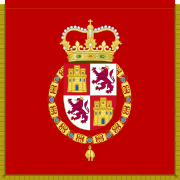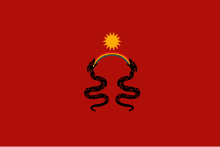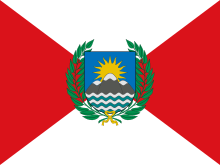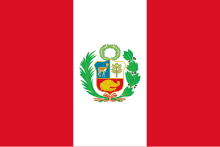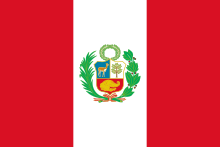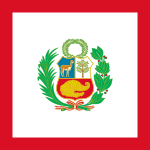Peru's flag
The flag of Peru is a rectangular flag made up of three vertical bands of equal width, the lateral ones red and the central one white. It is a national symbol of Peru. It has variants for different uses: the Peruvian State uses the national flag and the war flag, which include the national coat of arms in the center with different adherents; while civilians use the national flag, in a simple way, without the national coat of arms.
The original national flag of Peru was displayed for the first time in the Plaza Mayor of Lima, on July 28, 1821, at the time of the proclamation of independence by General José de San Martín. The design of this first flag was different from the current one, and only its colors have been maintained. The Peruvian army since 1821 uses the national flag to differentiate itself from other military forces. The current flag was established on February 25, 1825, during the government of Simón Bolívar.
On June 7, Flag Day is celebrated, commemorating the anniversary of the battle of Arica; and on August 28 the Flag Procession, in the city of Tacna.
Description
It is rectangular in shape. It is composed of three stripes of equal width arranged vertically: one white in the center and two red at the ends. It has a ratio of two for the width and three for the length (2:3).
Official institutions use a version with the national coat of arms in the center of the white stripe with its stamp embraced by two branches, one of palm on the right and the other of fruity laurel gules on the left, intertwined at the bottom.
Design
During the government of Manuel A. Odría, the current official design of the Peruvian flag was established, through Decree No. 11323 of March 31, 1950, which dictates its proportions and measurements.
The size of the flags and pavilions will be proportional to the one that corresponds to the place, camp or boat where it should be ized. The length of the stall will be at least three times greater than the length of the corresponding flag or flag, to facilitate the wave.Article 6 of the Act on the Bond symbols of 1950.
Until then, the National Flag wore the National Shield in the center; with the aforementioned law, this was removed.
National flag for izar. - Rectangularly, with the national colors, without shield of arms, of compulsory use in the buildings, houses, factories, camps boats, etc., of particular property, in The days of home parties, or when ordered by Special Law or Decree.Article 8 of the Law on the Path symbols of 1950
Colors and their meaning
The current colors of the Peruvian flag were taken from the design of San Martín and Torre Tagle. The reasons for the choice of red and white are not known (see the section on the provisional flag of 1820 for historians' theories).
There are no official tonalities determined by Peruvian law. However, there are some particular initiatives in approximate equivalences in multiple color models, some in shades close to crimson.
| Color model | Red | White |
|---|---|---|
| Pantone | 485 C | White |
| RGB | (217, 16, 35) | (255, 255, 255) |
| CMYK | (0, 93, 84, 15) | (0, 0, 0, 0) |
| HTML *(It's not a color model. HTML uses RGB) | #D91023 | #FFFFFF |
Officially, government communications have used various shades of red.
Official flags
History
Viceroyalty
The Viceroyalty of Peru was created by King Carlos I on November 20, 1542, from the governorates of Spain formed after the Conquest and Emancipation of Peru in the 16th century. The viceroyalty was part of the possessions of the Spanish monarchy, whose "royal standard" It was a common emblem in the territories of Spain, which was walked and raised in various circumstances. It represented Royal power and served as an insignia for the people to express their loyalty to the Crown". The royal standard had a star and three crowns on one side, symbol of the epiphany, and on the other the royal coat of arms of Castilla y León, and it was the one that was awarded to José de San Martín in Lima. The banner of the conquest, or of Pizarro, carried the image of the Apostle Santiago on one side and the royal coat of arms of Castilla y León on the other side, and was the one that was delivered to Simón Bolívar in Cuzco. Spanish military banners were a flag with the cross of Burgundy on a white, yellow or blue cloth, during the lifetime of the royal house of Austria; Although it was not exactly a Spanish national flag, it is considered an antecedent of it. With the advent of the royal house of Bourbon, the previous design was replaced by another: the royal arms on white cloth. In 1785 the current design of the flag of Spain arose, to differentiate itself from other Bourbon kingdoms: three horizontal stripes, the widest central one yellow in color, and the other two red, with the royal coat of arms in the center. The naval fortresses, fleets and armies of the Spanish Empire used their respective private flags in America during the Viceroyalty. The battle of Ayacucho signaled the end of the Peruvian viceroyalty in 1824. The so-called "Bandera Real" It is a contemporary reconstruction of the battle of Ayacucho with the symbols of a Spanish regiment, it erroneously superimposes the Burgundy cross on the colors of the red flag and gold in use in 1843, during the reign of Isabel II, on the other hand it was also a symbol of the Spanish national militia of Diego Muñoz Torrero during the Cortes of Cádiz (1812).
Emancipation
Tupac Amaru flag
On November 26, 1780, in Tungasuca, José Gabriel Túpac Amaru, was proclaimed and crowned as Inca-King of Peru, initiating an emancipatory revolution, hoisting a crimson flag with the heraldry of the Incas, based on the flag used by the Inca Tupac Amaru. This flag represented a new government that should be established in the territory of the Viceroyalty of Peru under the reign of Don José I Túpac Amaru.
Tupac Amaru had two. flags of tafetan carmesi at the door of the house he occupied [..]Huerto Vizcarra Héctor
Flag of the La Paz revolution
On July 16, 1809, a government junta was formed in La Paz, headed by Pedro Domingo Murillo, in which a red and green flag was designed, with which all the " inhabitants of La Paz and the entire Empire of Peru" to join the revolutionary cause.
Valuable inhabitants of La Paz and of the whole Empire of Peru, reveal your projects for execution; take advantage of the circumstances in which we are; do not look with disdain at the happiness of our soil, and never lose sight of the union that must reign in all, to be henceforth as happy as misfortunes to the present.Proclamation of the Tuitive Board
Flag of the revolutions of Tacna and Cuzco
On June 20, 1811, the movement of Francisco Antonio de Zela took place in Tacna against the viceregal authorities, but no flag of the Tacna de Zela Insurrection is known. In the same period of autonomous uprisings in Peru, that of Tacna in 1813 used a flag with the colors light blue and white. This movement coordinated its action with the Governing Board of the Río de la Plata. It is a flag used by Manuel Belgrano. The Bourbon colors —light blue and white— were used in the rebellions of Tacna 1813 and the rebellion of Cuzco 1814.
During the action of the liberating currents of America, the British officer of the Liberation Army of Peru Guillermo Miller raised a flag in the city of Tacna that sought to unite the independent Peruvians in a regiment. It was a navy blue flag with a golden sun (perhaps the Inti) inside. This flag was lost, but its description remained.
... Without less difficulty they joined Lieutenant Colonel Miller... which gave Cochrane the opportunity to conceive the thought of forming a regiment with the title of "Independants of Tacna" and which had so simple its realization, that he came to give a blue flag with a sun in the center.
Miller's Flag
In his memoirs William Bennet Stevenson indicates that when Miller was in Tacna, there was no known flag that would represent the independent troops of Peru, so for the independent regiment of Tacna they used this blue flag with a sun on the center.
... under the command of Lieutenant Colonel Miller came out of Arica and marched to Tacna... Lord Cochrane ordered that they form the base of a new regiment that would be called the first independent of Tacna, and as had not yet been designated in the headquarters the particular flag of the troops of Peru, SS presented them with a sun in the center on a blue field.
This flag is mistakenly found in some listings as the first national flag of Peru. In addition, there is a controversy as to whether Miller's flag was raised in Tacna in 1820 or in 1821, since there is no known expedition prior to that of Pisco by José de San Martín, and Miller would have only arrived in Tacna on May 17. of 1821. Miller's could be a free version of the Argentine flag created by Belgrano in 1811.
National flag
Provisional flag (1821)
It was created by General José de San Martín with the following description given in the first article of the decree of October 21, 1820:
It will be adopted by national flag of the country one of silk, or canvas, eight feet long, and six wide, divided by diagonal lines in four fields, whites the two of the upper and lower ends, and incarnated the sides; with a crown of oval laurel, and within it a Sun, leaving behind steep mountains that rise on a quiet sea. The shield can be painted, or embroidered, but retaining each object its color: namely, the crown of laurel must be green, and tied at the bottom with a golden ribbon; blue the top that represents the firmament; yellow the Sun with its rays; the mountains of a dark brown color, and the sea between blue and green.
In the same decree it is determined that the force and vigor of his mandate will be until a general government is established in Peru by the free will of its inhabitants.
In the National Museum of Archaeology, Anthropology and History of Peru of Pueblo Libre, what is considered the oldest flag of free Peru is kept. It is a vertical banner with the San Martin design cataloged in 1916 and dated 1920; according to the catalog it was used on June 4, 1821 when independence was declared in Piura.
The origin of the flag is not known for sure. In 1917 Abraham Valdelomar published the story The Dream of San Martín where he narrates that General José de San Martín, having disembarked on the southern coast of Pisco (Independence Bay in the current Paracas National Reserve), was inspired by the colors of the parihuanas, flamingos with red wings and white breasts.
Historian Mariano Felipe Paz Soldán explains that the Peruvian flag has red and white colors because José de San Martín took the red from the Chilean flag and the white from Argentina, which were countries he had liberated and part of the Liberation Army in Peru it was made up of men from these nations, mostly freed blacks.
Paz Soldán's proposal about the colors was refuted by Jorge Fernández Stoll, who argues that José de San Martín was not based on the flags of Argentina and Chile, since the predominant thing on the Argentine flag is the light blue color, not the white one; And in the Chilean flag, what is essential is not the red color but the shape and arrangement of the flag.
Fernández Stoll explains that in September 1820 San Martín was in favor of a Constitutional Monarchy, so he used monarchical symbols to define the flag. For several centuries the flag of the Crown of Castile was red and white. In addition, the diagonal lines sought to represent the Red and White Cross of Burgundy, which was the flag of the Viceroyalty of Peru. He also adds that the red color of the Peruvian flag is due to the red of the mascaipacha that the Sapa Incas used as a crown and the red of the emblem of the king of Spain.
During the government of Torre Tagle (1822)
In March 1822, José Bernardo de Tagle, Marquis of Torre Tagle and Supreme Delegate of the Republic (who temporarily replaced San Martín when he traveled to Guayaquil), decreed a new design. The composition established a white stripe transversal embedded between two red ones of the same width, with a red sun in the center, similar to the sun on the patriotic flag used by Guillermo Miller. The modification made responded, according to Torre Tagle, among other things, to the inconveniences that "the construction" of the previous flag.
"The National Flag of Peru will consist of a cross-sectional white strip between two incarnated in the same width, with a sun also incarnated on the white strip."Government Gazette, No.22, Second Volume on Saturday, March 16, 1822
A problem arose on the battlefields: the resemblance to the Spanish flag made it difficult to differentiate between the armies, which caused a new change of the flag made official by the decree of May 31, 1822. The new order of the Marquis de Torre Tagle established a version made up of three vertical bands, red at the ends and white at the center, with the red sun in the center of the white band.
The National Flag of Peru will be three vertical or perpendicular lists, that of the white center, and that of the ends incarnated with a sun also incarnated on the white list. The banner will be equal in everything to the flag with the difference that instead of the sun, will carry the provisional weapons of the state, embroidered on the center of the white list."Government Gazette, No.47, Second Volume on Wednesday, June 12, 1822.
National flag (1825)
On February 25, 1825, during the government of Simón Bolívar, the Constituent Congress changed the design of the flag through the promulgation of the law of patriotic symbols. The fundamental change was that of the image of the sun for that of the Brand new coat of arms, designed by José Gregorio Paredes and Francisco Javier Cortés.
3.o The national flag and flag will consist of three vertical stripes, the two extremes incarnated, and the white middle, in whose center the shield of the weapons will be placed with its ring, embraced by the inner part of a palm to the right and a laurel branch to the left intertwined. The flag of merchant ships will be simple, without shield or other badge.Law of February 25, 1825 establishing the shield of arms, great seal of the state,...
In this way, the flag was definitively made up of three vertical bands of red at the ends and white at the center, with the coat of arms in the center of the middle band. The shield is made up of three fields that represent the three kingdoms of nature, present in the Peruvian territory. The animal kingdom is represented on the left side of the shield by the vicuña on a light blue background; the vegetable kingdom is represented on the right side by the quina tree, on a white background; and below the previous fields, on a red background, the mineral kingdom is represented by the cornucopia of abundance. In addition, it had a crown for its stamp and was embraced from its lower part by a palm on the right and a laurel branch on the left.
Peru-Bolivian Confederation (1836-1839)
During the Peru-Bolivian Confederation, Peru was divided into two states, the North-Peruvian State, the South-Peruvian State, both of ephemeral existence, which constituted an egalitarian Confederation of three states with the Bolivian State. After its dissolution, the Peruvian Republic unified both States and restored the flag of 1825.
Flag of the Confederacy
The flag of the Peru-Bolivian Confederation was made up of a red or red background on which the shields of the conforming Republics were shown surrounded by a civic crown. From left to right the shields were: that of the Republic of Bolivia (second historical coat of arms), that of the South-Peruvian State and that of the North-Peruvian State (the same as the previous Republic of Peru).
The flag of the Confederation will be of color punctuated by being common to the three republics. At its centre you will see the weapons of the Confederation, which are those of the three republics intertwined by a laurel; the design will be given by the ProtectorBasic Law of the Peruvian-Bolivian Confederation, article 37
Flag of the North-Peruvian State
The flag of the North-Peruvian State maintained the design of the Peruvian flag of 1825.
Flag of the South-Peruvian State
The flag of the South-Peruvian State was made up of a vertical red field on the left and two horizontal fields on the right of green (above) and white (below). On the red band, a sun and four surrounding stars were superimposed on top representing the four initial departments. It is presumed that during the life of the South-Peruvian State, the fifth star above the sun was added to the emblem, representing the Department of Littoral, a situation that is evident in the coins minted by the same State. The colors of the flag represent the union of the common colors of Peru and Bolivia, since Sud-Peru represented the union and integration of both countries.
Restoration (1839)
After the restoration, the symbols of the Peruvian Republic were restored throughout the national territory, that is, the flag of 1825.
1950 Modifications
On March 31, 1950, President Manuel Odría modified the use of the flag to its current form, that is, making the flag for the merchant marine (simple model, without the shield) the national flag, and reserving the flag with a different coat of arms in the center for official State institutions. The change was due to the fact that the simple model was used de facto as it was quicker to make.
In addition, it made official a new banner similar to the previous one, which would carry the national coat of arms accompanied by flags and banners instead of palm and olive branches. That was since then the official banner of the Armed Forces.
Proposed Flag (2022)
In 2022, Congresswoman Nieves Limachi proposed a change of flag. The new flag was created by Marco Fortunato Mendoza Huamán, a citizen of Tacna. The meaning of this flag is as follows:
- Green: it is representation of the Jungle
- Yellow: symbolizes the earth
- Blue: represents the sea
- Red: is a symbol of the Costa
- The Sun: symbolizes life and commemorates the god of the Incas.
Variants
Institutional flag and flag
The institutional version of both the flag and the pavilion includes the Coat of Arms in the center.
Until 1950, the flag and the flag were made the same, but with Manuel Odría's modification, the flag became the state flag.
Flag and flag of war
The war flag is the national emblem of a single model that is delivered to the Military and Police Armed Forces for ceremonies, parades, parades and to distinguish them when they are active. It is made up of the national flag with the National Shield in the center. The shield is framed by banners. Each unit carries as a banner this flag with the name of its unit in gold letters in the form of an arc under the shield.
Flag of the bow
Peru also uses its own bow flag on its ships: it consists of a quadrangular cloth with a red border with the Coat of Arms in the center. On the mast of the ships of the Peruvian squadron and on this bow flag, the insignia of the highest-ranking officer on board or that of the President of the Republic is usually placed, if this were the case.
National Standard
The National Banner is the portable version of the National Pavilion, to be used without waving inside buildings. It has a smaller format (1.40 × 0.93 m) and sometimes with the shield tilted 45º so that it is visible when resting on the pole and with a lower band or cord that prevents it from waving.
“March of flags”
The «March of flags» is a musical creation sung at the moment of hoisting the flag, composed and proposed by maestro José Sabas Libornio Ibarra in 1895, during the constitutional government of Nicolás de Piérola.
Flag Day
June 7th of each year is commemorated in Peru on Flag Day, which is the day on which the anniversary of the battle of Arica is celebrated, where Colonel Francisco died heroically Bolognesi and his subordinates fighting superior forces, in the context of the Pacific War.
This tribute was established by Supreme Decree of April 30, 1924, during the Oncenio of Augusto B. Leguía; although before, by Supreme Decree of November 8, 1905, the oath of fidelity to the national flag had been decreed that the conscripts had to take publicly and solemnly.
Although it is not considered a holiday, state agencies, as well as public and private schools, perform the corresponding ceremonies on that day; In Lima, the main ceremony takes place before the monument to the hero Francisco Bolognesi in the square named after him, with the presence of high-ranking government and army authorities, where the oath of allegiance to the flag is sworn.
Contenido relacionado
History of japan
Princess of Asturias Awards
Slovenia







